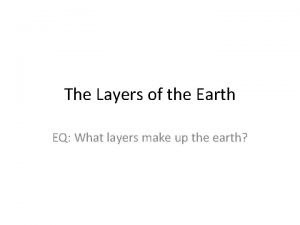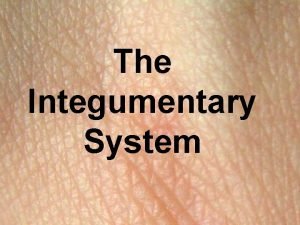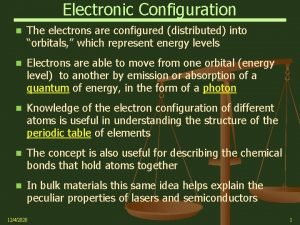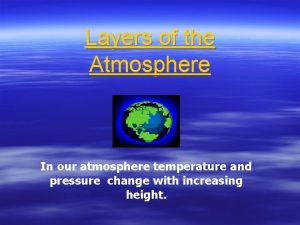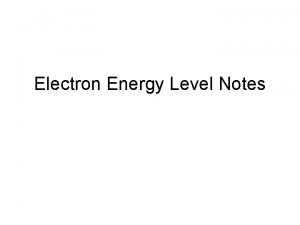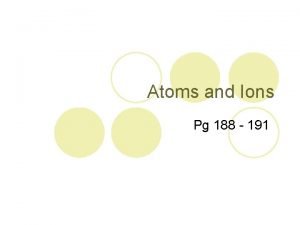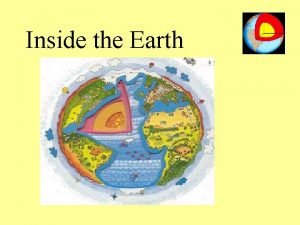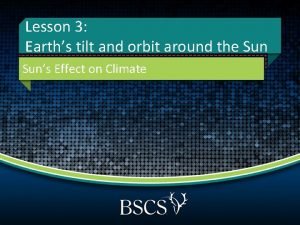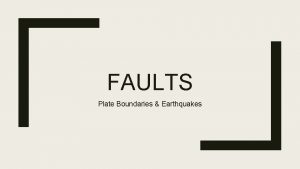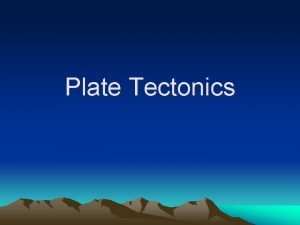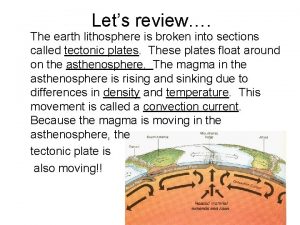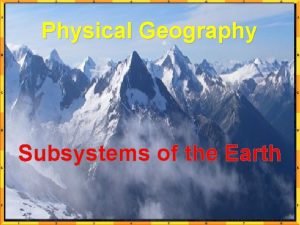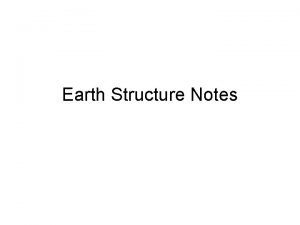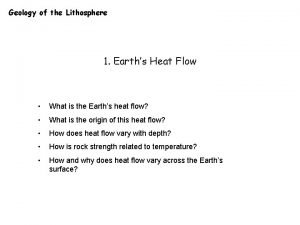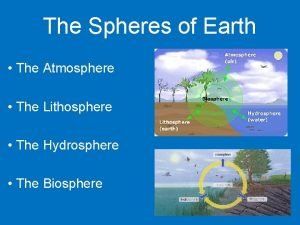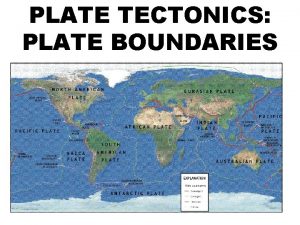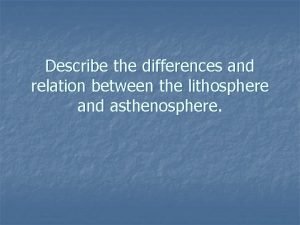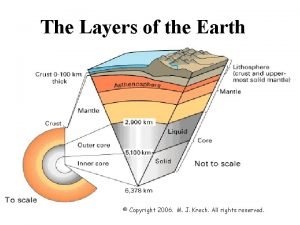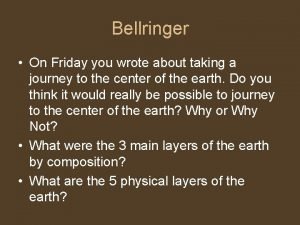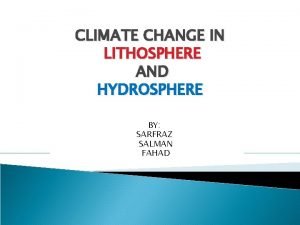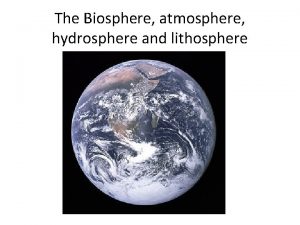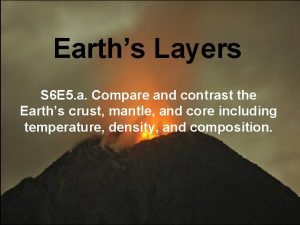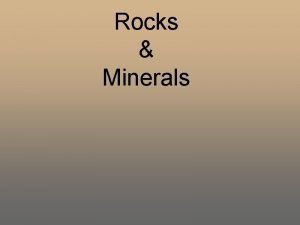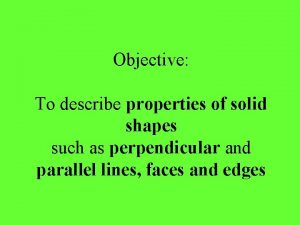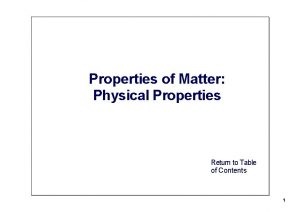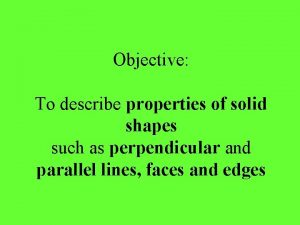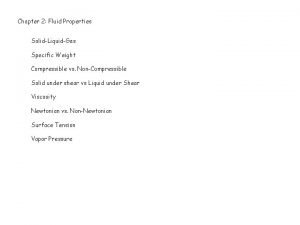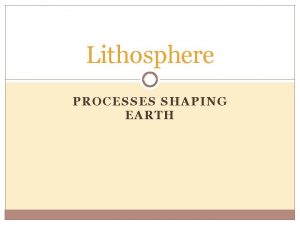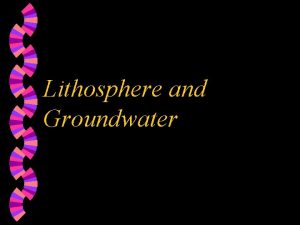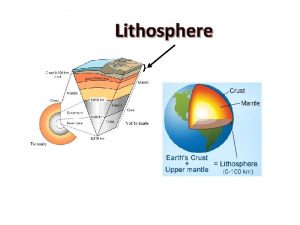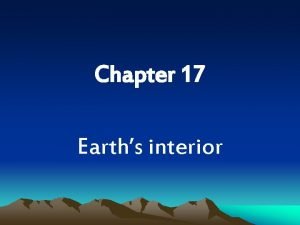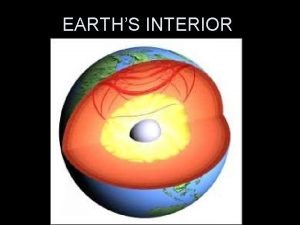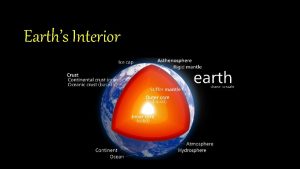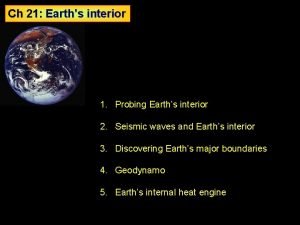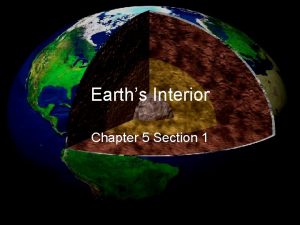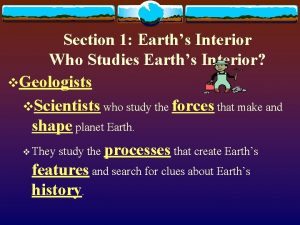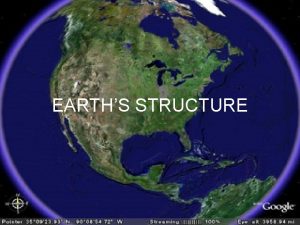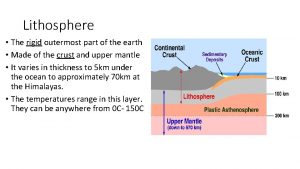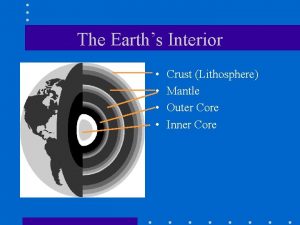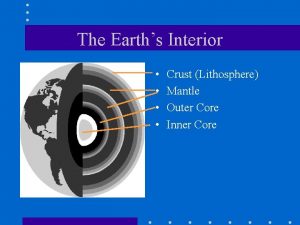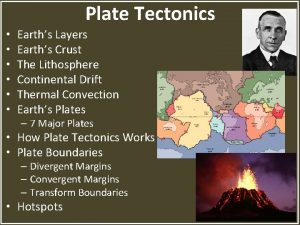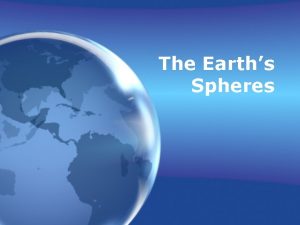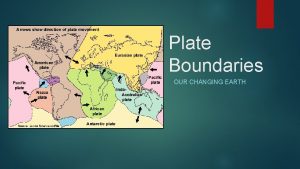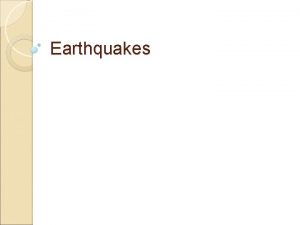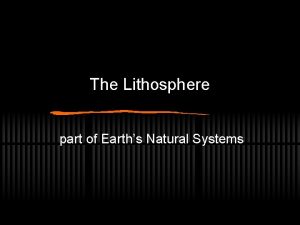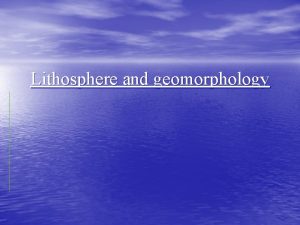Properties of Earths Interior Lithosphere the solid outermost















































































- Slides: 79

Properties of Earth’s Interior


• Lithosphere: the solid outermost part of Earth – Includes the crust and upper mantle

• Crust: the rocky solid shell that floats on the asthenosphere – Includes the ocean floor

• Asthenosphere: plastic mantle- made of molten material

• Mantle: Located between the crust and the core

• Outer core: liquid- moves around the solid inner core creating a magnetic field

• Inner core: solid

ESRT page 10

• MOHO: the boundary between Earth’s crust and upper mantle

Earthquakes • An earthquake is the shaking of Earth’s crust caused by a release of energy

Possible causes? • Interaction between lithospheric plates

Damages • Buildings and bridges collapse, fires, water shortage

Focus • Located underground where the movement or break began

Epicenter • Located on Earth’s surface directly above the focus

Occur at. . • Plate boundaries

P waves • • Compression/ primary waves 1) back and forth motion 2) travel fastest- arrive first at a location 3) travel through solid, liquid, or gas

S waves • 1) travel perpendicular to the direction of movement • 2) about half the speed of P waves • 3) travel only through solids

• As seismic waves travel through earth’s interior they bend (science word). • Creates a Shadow zone: areas that get no earthquake waves


Locating the epicenter • Minimum of 3 seismic stations needed.

Measuring Earthquakes • Richter scale: measures an earthquake’s magnitude. – Uses seismographs – Each successive number is 10 x greater than the previous



Measuring Earthquakes • Mercalli Scale: measures earthquakes intensity based on reports from people who experienced the event


How to Use the Earthquake Travel Time Graph (Page 11 of the Earth Science Reference Tables). The graph on page 11 can be used to find several different variables. Let’s start with: A seismic station is 3000 kilometers from the epicenter of an earthquake. How long will it take P waves from this earthquake to reach the seismic station?

We know the distance (3000 km) We’re trying to find the time it will take P waves to travel this distance. Find 3 (really 3000 km) on the bottom axis and, using a straight edge (a ruler) draw a line up to meet the P wave line. Now, using the ruler, draw a line over to the left axis and read the travel time: 5 minutes and 40 seconds. Notice that each small box is worth 20 seconds. Now try the same problem in reverse: It takes P waves 5 minutes and 40 seconds to travel from an epicenter to a seismic station. How far is the seismic station from the epicenter?

We know the P wave travel time: 5 minutes and 40 seconds. We are trying to find the distance between the epicenter and the seismic station. Using a ruler, draw a line from the time (5: 40) to the P wave line. Now draw a line straight down to the bottom axis and read the distance. . . 3000 kilometers! All of these problems are the same. Given the time, find the distance. Given the distance, find the time. And it doesn’t matter whether you are given P or S wave travel time as long as you are careful to use the correct line and, most important: TAKE THE TIME TO BE CAREFUL AND ACCURATE!

It takes P waves 7: 20 (7 minutes and 20 seconds) to travel from an earthquake epicenter to a seismic station. How long will it take S waves from the same earthquake to reach the seismic station? We have to divide the problem into 2 parts. First, we do just what we did in the previous problem. We use the P wave travel time to find the distance to the seismic station and then. . . . We use the distance to the seismic station to find how long it took S waves to travel that same distance. Let’s see how it’s done. . . . .

We know P wave travel time is 7: 20 so, using a ruler, draw a line from 7: 20 over to the P wave line. Now draw a line straight down to find the distance from the epicenter. . The distance is 4200 km. Notice that each small box on the bottom axis is 200 km. Now we can get on with the second half of the problem. If the seismic station is 4200 km from the quake epicenter, how long (time) did it take the S waves to travel that same distance? Draw a line from 4200 km straight up to the S wave line. Now draw a line over to the vertical axis and read the time. . 13 minutes exactly (13: 00) And now for something completely different. . .

Let’s take this one step further. A seismic station is 3000 km from the epicenter of an earthquake. If P waves from that quake arrive at the station at 4: 25: 40 PM (4 hours, 25 minutes and 40 seconds), at what time did the earthquake occur? We do exactly the same thing we did before, we find the travel time which is 5: 40 (5 minutes, 40 sec. ) Now some math. If the waves arrived at 4: 25: 40 and they’ve been traveling for 5: 40, when did they start out? Subtract: 4: 25: 40 ------4: 20: 00 The quake occurred at 4: 20: 00 PM

Determining Arrival Time Differences • 1. find the distance on the bottom of the chart • 2. place a scrap paper vertically for that distance • 3. Mark the scrap paper where the s wave and p wave touch it. • 4. move the paper to the left of the chart. Place one mark at zero and read the time using the mark above it.


Determining Distance using differences in time • 1. Place a scrap paper on the left side of the chart • 2. Mark the zero and the arrival time difference on the paper • 3. keep the paper vertical and move it to the right until the top mark is touching the s wave line and the zero mark is touching the p wave. • 4. follow the paper down and read the chart to determine distance

A seismic station is 3000 km from the epicenter of an earthquake. How long after P waves arrive will S waves from the same earthquake arrive at the station? This time place your paper on the 3000 km mark taking care to keep the paper straight and to cover both the P and S wave lines. Make small, thin, and accurate marks where your paper crosses the P line and the S line. Then. . . .

Another type of question involves the “difference in travel time between P waves and S waves”. Whenever you are given the difference in arrival times OR you are given both times so that you can subtract and find the difference, you should immediately realize that you will be dealing with the shaded area (yellow) between the two lines. Here’s a sample problem: P waves arrive at a seismic station 4: 30 (4 minutes, 30 seconds) before the arrival of S waves from the same earthquake. How far from the epicenter is the seismic station?

Here’s what you know: P & S waves arrive at a seismic station 4 minutes and 30 seconds (4: 30) apart. You are asked to find the distance to the epicenter. Here’s how: 1) Take a sheet of paper and line up the left edge with the vertical axis (time). Be sure that most of the paper is hanging down below the graph. This is important. 2) Make a small, thin, and accurate mark on the paper at 0 time. Make another small, thin, and accurate, mark at 4: 30 (4 minutes, 30 seconds). Your 2 marks are now 4: 30 apart!

Now slide your paper to the right until one of your marks is exactly on the S wave line and the other is exactly on the P wave line. It is very important to be sure your paper is straight (vertical). Now look to see where the bottom of your paper crosses the lower (epicenter distance) axis. In this case it crosses at exactly 3000 km which is the answer. When P & S waves arrive 4 minutes and 30 seconds apart it means that the seismic station is exactly 3000 km from the epicenter of the quake. Of course we can do the same problem in reverse!

One last kind of problem to become familiar with. Sometimes, instead of giving you the difference in arrival times, you will be given a seismogram (a record made by a seismograph) instead. Using this seismogram find when the P waves and the S waves arrive. Do this by carefully making a mark at the P wave and S wave arrival times. Now count the number of minutes between the arrival of P and S waves at the station. From this point on it’s just like the previous problem: If the difference in arrival times between P and S waves is 6 minutes, how far is the seismic station from the epicenter of the earthquake?

One last type of problem: Find the ‘time of origin of the earthquake’. In other words, use the information given to find out when the quake occurred. Here’s a sample problem: A seismic station is 4000 km from the epicenter of an earthquake. P waves arrive at the station at 2: 48: 00 PM. At what time did the earthquake occur? First, use the distance to find the P wave travel time. OK, the P waves took 7 minutes to travel the 4000 km distance. If they arrived at 2: 48: 00 and the trip took 7 minutes, they must have started out 7 minutes before 2: 48 PM So subtract. 2: 48: 00 - 7: 00 -------Origin time: 2: 41: 00 PM

Let’s try another one: P waves arrive at a seismic station at 4: 22: 10 AM. S waves from the same earthquake arrive at 4: 28: 50 AM. What is the time of origin of the earthquake? First subtract to get the difference in arrival times: 4: 28: 50 - 4: 22: 10 -------difference = 6: 40 (6 min, 40 sec) Now, as we did before, get a piece of paper and carefully and accurately make marks at time 0 and time 6: 40

Slide the paper until one mark is on the P wave line and the other is on the S wave line. Now read the distance from the epicenter on the bottom: 4000 km. Now that we know the distance to the epicenter we can easily tell how long it took P waves to travel that distance. P waves took 7 minutes to travel the 4000 km and since they arrived at 4: 22: 10 we can subtract to find out when they started. 4: 22: 10 - 7: 00 -------Origin time: 4: 15: 10

Plate Tectonics • Continental Drift: The theory that Earth’s crust is resting on a fluid which allows it to move – The crust is broke up into pieces called plates that move relative to each other

Evidence for Continental Drift • Shape of the coastlines: continents fit together

Evidence for continental drift • Correlations: fossils match across ocean basins – Rocks match across ocean basins

Evidence for continental drift • Climate changes: coal found in Antarctica. – Glacial striations in Australia and Africa.




What happens to the age of oceanic crust as distance increases from a ridge?

Age of Oceanic Crust Courtesy of www. ngdc. noaa. gov

Movement of Plates • Convection currents within the asthensphere move the plates that rest on the top

Convection currents • Currents caused by differences in density

Rising currents • Causes the plates to move apart- divergent plate boundaries

Falling currents • Cause the plates to move togetherconvergent plate boundaries

Divergent boundaries • A location where two plates are moving away from each other • As plates separate, water fills low areas • Formation of mid-ocean ridges • Youngest rock located at center

Divergent plate boundaries • Some igneous rocks contain minerals that are magnetic • Instruments measure small changes in magnetism • Bands of igneous rock on the ocean floor show that Earth’s magnetic orientation has been reversed in the past

Divergent plate boundaries • Crust must have shifted • Magnetic reversal supports sea floor spreading

Evidence that plates are moving apart: • Ocean floor is generally younger than the continents • Rocks continually form at mid ocean ridges. • Heat flow is highest at the spreading center • Magnetic reversal

Convergent boundaries • Continental/ Continental NOT Collision • Two plates collide • Cause crust to be pushed upward, forming mountain ranges – Himalayan – Andes

Continental/Continental • Effects: – intense folding and faulting, – a broad folded mountain range, – shallow earthquake activity,

Subduction boundaries • One plate goes under (subducted) the other plate

Ocean/Continental Plates • Ocean plate is more dense than the continental plate and is subducted • Bordered by a mountain chain and volcanoes on the continental plate – Andes mountains

Ocean/Continental • Effects: – earthquakes – ocean trench off shore of the continent, – a line of volcanic eruptions inland from the shoreline.

Ocean/ Ocean Plates • one ocean plate is subducted under the other. • Usually the older one • Effects: – deeper earthquakes – an oceanic trench – a chain of volcanic islands

Transform Boundaries • Plates that slide past eachother • Stress builds up between plates • Major earthquakes – San andres fault

Bench Marks • Locations labeled with exact elevation • Able to measure the change in elevation

Uplift of fossils • Fish and marine fossils found on mountain tops

Subsidence of fossils • Shallow water fish buried deep in the ocean floor

Looking at rock strata • folded • faulted

Looking at rock strata • Undisturbed • tilted

Hot Spot • A place where magma is coming through earth’s crust – Hawaiian islands

Hot Spots • Hot spots occur where rising material from the lower mantle remains stationary for millions of years. • When a plate moves over the rising materials, it melts. • Become regions of intrusive and extrusive volcanic activity that can build volcanoes and lava flows. • Can also push up regions to create mountains.

Hot Spots Cont. • As the plates move over the rising material, a series of volcanic mountains can form for thousands of miles. • These trails show the path of the plates past movements.




 Earths interior
Earths interior Hard and rigid the earth's outermost and
Hard and rigid the earth's outermost and Thermosphere pictures
Thermosphere pictures Encephalon parts
Encephalon parts Outermost layer of the eyeball
Outermost layer of the eyeball Layers of skin from outermost to innermost
Layers of skin from outermost to innermost Chongfu parent volunteer
Chongfu parent volunteer 5s 25p6 is the outermost electronic configuration of
5s 25p6 is the outermost electronic configuration of Cerebrum
Cerebrum Layers of skin from outermost to innermost
Layers of skin from outermost to innermost Mesosphere temperature
Mesosphere temperature Electrons in an atom's outermost orbitals are called
Electrons in an atom's outermost orbitals are called Cerebrum outer layer
Cerebrum outer layer Valence electrons of each group
Valence electrons of each group What is inside of earth
What is inside of earth What does earths tilt do
What does earths tilt do Whats the name of earths moon
Whats the name of earths moon Brown earth soil ireland
Brown earth soil ireland Basalt
Basalt Layers of atmosphere
Layers of atmosphere Is lithosphere part of the crust
Is lithosphere part of the crust Whats earths moon called
Whats earths moon called Earths boundaries
Earths boundaries Study of earth's physical features
Study of earth's physical features Continental drift theory notes
Continental drift theory notes Whats earths moon called
Whats earths moon called What is this shape
What is this shape Earths major crustal plates
Earths major crustal plates Forest desert tundra grassland
Forest desert tundra grassland Earths 4 spheres
Earths 4 spheres Honey fertilizer
Honey fertilizer Earths crust
Earths crust Which layer of the earth slowly moves like putty
Which layer of the earth slowly moves like putty The earths layers foldable
The earths layers foldable Arch of constantine dimensions
Arch of constantine dimensions Earths orbit seasons
Earths orbit seasons What are the families of the periodic table
What are the families of the periodic table What does the earths tilt cause
What does the earths tilt cause Earths early atmosphere contained
Earths early atmosphere contained Earths roation
Earths roation Two plates spread or move apart at what boundary
Two plates spread or move apart at what boundary The lithosphere is broken into
The lithosphere is broken into Lithosphere
Lithosphere Lithosphere ecosystem
Lithosphere ecosystem Which of earth's layers is the thickest
Which of earth's layers is the thickest Heat-mass transfer and geodynamics of the lithosphere:
Heat-mass transfer and geodynamics of the lithosphere: Hydrosphere
Hydrosphere What layers of earth make up the lithosphere
What layers of earth make up the lithosphere How do humans impact the lithosphere
How do humans impact the lithosphere Cross section convergent plate boundary
Cross section convergent plate boundary Lithosphere definition
Lithosphere definition Lithosphere
Lithosphere Earth layers lithosphere asthenosphere mesosphere
Earth layers lithosphere asthenosphere mesosphere Lithosphere
Lithosphere Lithosphere
Lithosphere Biosphere
Biosphere Crust mantle core
Crust mantle core Example for solid solution
Example for solid solution Crystal solid and amorphous solid
Crystal solid and amorphous solid Interpenetration of surfaces
Interpenetration of surfaces Covalent network solid vs molecular solid
Covalent network solid vs molecular solid Crystalline solid and amorphous solid
Crystalline solid and amorphous solid What is evaporation in mixtures
What is evaporation in mixtures Crystalline substances
Crystalline substances Chem
Chem Crystallography types
Crystallography types When a solid completely penetrates another solid
When a solid completely penetrates another solid Nonliving solid with crystal like properties
Nonliving solid with crystal like properties Their properties
Their properties Properties of solid shapes
Properties of solid shapes 2 hydrogen 1 oxygen
2 hydrogen 1 oxygen High pressure extruder
High pressure extruder Particles in motion
Particles in motion Properties of solid shapes
Properties of solid shapes Properties of solid
Properties of solid Properties of solid liquid and gas
Properties of solid liquid and gas Solid liquid gas information
Solid liquid gas information Properties of a solid
Properties of a solid Extensive vs intensive properties
Extensive vs intensive properties Chemical property of water
Chemical property of water

